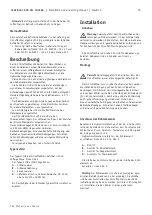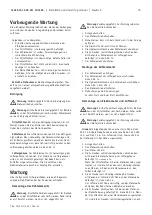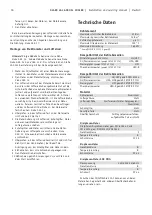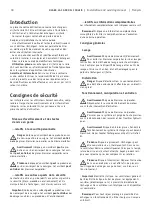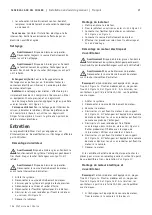
10
OLAER LAC AIR OIL COOLER |
Installation and servicing manual | English
6 Unscrew the screws with washers fixing the cooler
matrix to the fan housing.
See Figure 12.
7 Remove the cooler matrix.
Mounting of the cooler matrix
1 Locate the cooler matrix.
2 Fit the cooler matrix to the fan housing.
See Figure 12.
3 Connect the flexible hydraulic hoses to the cooler
matrix.
See Figure 4 and Figure 5.
4 Connect the electric motor power supply
5 Proceed to
Prior to start-up
and
At start-up.
Removing the electric motor and the fan
Caution
Risk of severe burns. The air oil cooler could
become extremely hot during operation. Make sure
the air oil cooler is cool before touching.
Caution
Risk of bodily harm. Prior to maintenance,
disconnect the electric motor power supply.
Note!
Some fan hubs are fixed,
see Figure 14
, and some
are detachable,
see Figure 15 A and Figure 15 B
. The fan is
balanced together with the hub as from size LAC-033.
1 Turn off the system.
2 Disconnect the electric motor power supply.
3 Secure the electric motor.
4 Unscrew the screws with washer fixing the motor attach-
ment to the fan housing,
see Figure 13.
If the air oil
cooler is fitted with a motor bracket, unscrew the screws
with washers fixing the motor bracket to the feet.
5 Unscrew the screw with washer fixing the fan to the
motor shaft.
See Figure 14.
Pull with care the fan and
hub from the motor shaft. Use a pulley if required.
6 Unscrew the screws fixing the motor to the motor
attachment.
See Figure 16.
If the air oil cooler is fitted
with motor bracket, unscrew the screws with washers
fixing the motor to the motor bracket.
7 Remove the motor.
If further dismounting of the fan is required, label all
details to ensure correct mounting, first of all with regard
to balance and direction of rotation.
See Figure 17.
Mounting of the electric motor and fan
Note!
Some fan hubs are fixed,
see Figure 14,
and some
are detachable, see
Figure 15 A
and
Figure 15 B.
The fan is
balanced together with the hub as from size LAC-033.
1 If the air oil cooler is fitted with motor bracket, fit the
motor to the motor bracket.
2 Secure the electric motor to the motor attachment.
See Figure 16.
3 Fit the hub groove to the motor spline. Lube the hub
with ethanol and secure the fan/hub to the motor
shaft. If required, knock carefully with e.g. a rubber
mallet. Use Loctite® on the screw and secure the
fan/hub on the motor shaft with screws.
See Figure 14.
4 Make sure that the fan is fitted to the motor shaft
with out too much play.
5 Place the motor attachment with fan, fan guard, motor
and bracket, if any, in the fan housing.
6 Adjust the fan guard and motor and secure the motor
attachment in the fan housing with screws.
See Figure 13.
Secure the bracket with screws.
7 Make sure that the fan is centered and rotates freely
(using hand force). If required, adjust the location of
the fan guard and motor.
8 Check the screws for tightness.
9 Connect the electric motor power supply.
10 Proceed to
Prior to start-up
and
At start-up.
Technical specification
Cooler matrix
Maximum static working pressure
21 bar
Maximum dynamic working pressure
14 bar*
Heat transfer allowance
± 6 %
Maximum fluid temperature
in the cooler matrix
120 °C
Maximum cooling capacity
160 kW
* Tested according to ISO/DIS 10771-1
Fluid compatibility
Mineral oil
(according to DIN 51524)
HL/HLP
Oil/water emulsion
(according to CETOP RP 77H)
HFA, HFB
Water glycol
(according to CETOP RP 77H)
HFC
Phosfatester
(according to CETOP RP 77H)
HFD-R
Material
Cooler matrix
Aluminium
Fan housing
Steel
Fan blades/hub
Glass fibre reinforced polypropylene/
aluminium
Fan guard
Steel
Other parts
Steel
Surface treatment
Electrostatic powder coated
3-phase motor
3-phase asynchronous motors in accordance with
IEC 60034-1 and IEC 60072 in accordance with
DIN 57530/VDE 0530
Insulation class
F
Rise of temperature
B
Protection class
IP 55
1-phase motor
Insulation class
B
Rise of temperature
B
Protection class
IP 44
3-phase motor LAC 004
Rated voltage
230/400V 50/60 Hz
Insulation class
B
Rise of temperature
B
Protection class
IP 44
LAC air oil coolers could have different material and
surface treatments.


















